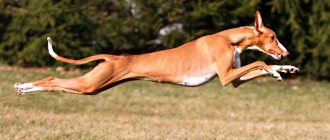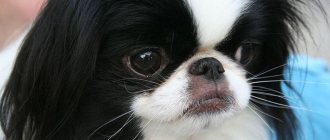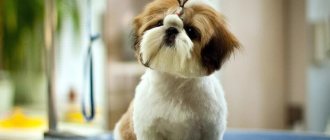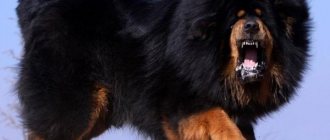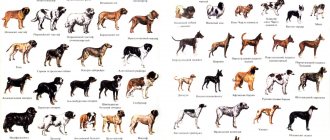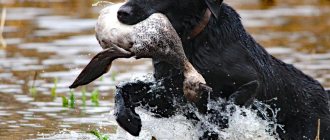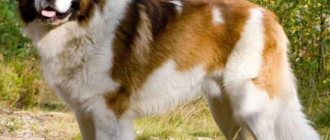They say that money cannot buy true love. But this is not entirely true. By buying a dog, you are acquiring not just a friend, but a creature infinitely in love with you, ready to faithfully follow on your heels, watch for the slightest changes in mood and be always there. Most dogs have these qualities, but not all breeds can be called successful for keeping in a small living space.
What kind of dog is better to have in an apartment? What criteria should you use to choose a pet? And what pitfalls are typical for popular “apartment” breeds? FAN journalist looked into these issues and compiled the top dogs for an apartment - from small to large breeds.
How to choose a dog for an apartment
To spend a lot of time with your pet on walks, play sports with him, go out into nature or go on hiking trips - active breeds with a genetic predisposition to endurance are suitable.
- all types of terriers;
- Border Collie;
- fox terriers;
- schnauzers;
- setters;
- all types of pinschers;
- retrievers.
The disadvantages include regular long-term exercise. A bored, energetic dog can organize an apartment-sized Armageddon in a few hours.
If you like leisurely walks, without baiting cats or chasing birds, you’d better get a
- mastino;
- chow-chow;
- Chinese Crested;
- Pekingese;
- English or French bulldog;
- pug.
These breeds have a balanced character. Such a friend can be kept even in a small apartment. You can take a closer look at medium or small breeds.
A large dog, calm and childish, will sleep half the day and not create any inconvenience. But, for example, the explosive nature of the terrier will ensure constant chaos in the territory. Such an active dog will constantly spin between its legs and try to contribute whatever “help” it can to the housework.
If you can withstand noisy fun, and also calmly accept jumping and running around, choose hunting breeds׃
- spaniels;
- dachshunds;
- all types of terriers - Yorkies; airdeli; Foxes; Jack Russell and others.
However, keep in mind that you will have to walk for 2 or 3 hours every day. If there is a platform nearby where you can run and jump, you can start it
- poodle (about its nutrition);
- Labrador
Representatives of these breeds are good for families with children. At home they behave quite calmly, do not cause mischief, and do not damage property. Of course, active walks and proper education are important here. Such dogs are suitable for novice dog breeders; they do not want to dominate and are easy to train.
Some people believe that they can get a decorative dog that will appear only when called, and will not require walking or attention. She will bring slippers and mysteriously disappear into the open spaces of the apartment. Others decide to give their child a living toy and do not think about the consequences. In such cases, you should immediately give up thoughts of getting a puppy and give your child a rabbit or hamster.
It doesn't matter what size the new member of your family will be. You will still have to walk him every day, as well as feed him, wash him, and educate him. And this will continue for many years. A small child cannot cope with this task. Therefore, adults should rely only on their own strength.
Other dog breeds for keeping in an apartment
Breeds that did not make it into our top 15, but often live with their owners in apartment buildings.
Small dogs for apartments
Dogs whose height does not exceed 40 centimeters.
Jack Russell Terrier
Restless little dog. When you are planning to get a Jack Russell Terrier, get ready for the fact that he will show all his truly unrestrained and energetic nature in your home. A very active, jumping dog will delight its owners, but is unlikely to suit inactive people.
Jack Russell Terrier. Photo: Cao Na Foto But such a pet is very unpretentious in maintenance.
Pomeranian Spitz
Compact Pomeranians are playful and at the same time courageous, intelligent and obedient, and amenable to training.
Pomeranian Spitz. Photo: Thanate Tan Provided they are regularly bathed and groomed, their presence in your apartment will not cause any inconvenience at all.
Shiba Inu
A cute dog with a memorable appearance and incredibly clean.
Shiba Inu. Photo: ChikoBirdyhof Brush your Shiba periodically and you won’t have to worry about discomfort, and this charming “Japanese” will delight others.
Shih Tzu
Caring for the coat of these decorative dogs is quite complex and includes not only frequent bathing, but also regular haircuts, preferably professional.
Shih Tzu. Photo: Michael Condouris Otherwise, Shih Tzus are very suitable for the role of a lap dog: they are calm, smart and affectionate, and easily get accustomed to their indoor toilet.
Medium sized dogs
We classified dogs whose height is between 40-60 centimeters as “medium” breeds.
English bulldog
A breed with a unique appearance and aristocratic habits.
English bulldog. Photo: Oka Tai-Lee This dog has many fans, has a lot of advantages, but also requires some effort in caring for itself - the owners of the bulldog need to regularly monitor the condition of its eyes and skin folds.
Shar Pei
A spectacular Shar Pei, surprisingly, does not require too much maintenance. It practically does not shed and does not smell.
Shar Pei. Photo: Jan-Erik Finnberg Care should rather be competent: the Shar Pei’s numerous folds should be inspected from time to time, and the coat should be combed with a furminator comb.
Chow chow
Chow Chows are stubborn and independent, but unpretentious in their maintenance.
Chow-chow. Photo: Jens Schott Knudsen Their thick coat does not require too much grooming, and their bright appearance attracts everyone's attention - the purple tongue alone is worth it!
Collie
Affectionate and sociable collies are quite common inhabitants of apartments. Their long, luxurious coat does not require trimming or frequent bathing; its main care is regular brushing.
Collie. Photo: shila009 Lovers of Scottish Sheepdogs living in cramped conditions should pay attention to the “smaller copy” of the Collie Sheltie.
Airedale
Erdel is quite unassuming. The most trouble comes from having to trim his coarse coat every month.
Airedale. Photo: JeffreyGee Overall, the Airedale Terrier is a wonderful dog with a lively mind, energetic and cheerful.
Bull Terrier
An unpretentious dog with an unusual appearance.
Bull Terrier. Photo: Storm Caring for a Bull Terrier is not difficult; it is enough to periodically comb its short fur and pay attention to the dog’s eyes.
English cocker spaniel
If you have a cheerful and cheerful English Cocker, get into the habit of regularly inspecting and cleaning his long, floppy ears.
English cocker spaniel. Photo: CPulidori In addition, timely bathing and brushing will help keep this handsome dog's coat in order.
Golden retriever
The Golden Retriever has a long, beautiful coat that can cause some discomfort if not brushed regularly.
Golden Retrievers. Photo: Elena Giglia Otherwise, this kind, smart dog is not burdensome and is very popular for keeping in apartment buildings.
Large dog breeds
Very large dogs - their height at the withers is more than 60 centimeters.
German dog
Surprisingly for such a giant, the Great Dane is quite easy to care for. The Great Dane does not have a “dog” smell; it is a balanced and kind dog. The main inconvenience – small, prickly hair during shedding – can be eliminated by regular brushing of the Great Dane.
German dog. Photo: Sheila Sund It will be much more difficult to place this giant in a small apartment - first of all, the famous expression “bull in a china shop” comes to mind.
Giant Schnauzer
"Rizen" also does not have an unpleasant odor, and it practically does not shed - a significant advantage for an indoor dog.
Giant Schnauzer. Photo: Konstantin Zamkov Its hard, dense coat does not require frequent grooming, and the dog itself (with proper upbringing) successfully combines the qualities of an excellent nanny and an excellent guard.
If you think that the Giant Schnauzer is too large for your apartment, turn your attention to its “younger brothers” – the Miniature Schnauzer and the Miniature Schnauzer.
Sex question
There is not much difference between small dogs. But after six months, the characters of “boys” and “girls” will differ. It is always difficult for inexperienced owners to choose which puppy to get.
It is easier for male dogs to “explain” the norms of behavior, but if a bitch in heat appears nearby, your pet will simply go crazy. He can run after the “bride”, get into a fight with competitors, have sexual intercourse and pick up some kind of infection. There is no use telling him off.
In bitches, “sexual psychosis” occurs only twice a year. They are much more cunning than straightforward males, they act on the sly, slowly expanding the boundaries of what is permitted.
The “gender question” is indeed a problem. The big dog can break free and run away, the little bitch can gather a flock of evil aggressive “gentlemen” around her.
The best option is to have your pet spayed and neutered before puberty begins. A sterile dog is more obedient and less likely to conflict with other dogs.
If the dog will be walked by a child, sterilization is necessary. Male dogs fighting or mating are not the best for children's eyes, and it can also be quite dangerous.
Of course, this important issue will still have to be resolved if the goal is not to breed dogs. Males often mark, and females are not known for being clean during the period of heat.
What kind of dog gets along with a child?
Sometimes a dog has been with a family for a long time before the baby arrives. And it happens that parents decide to get a pet so that it grows up with the child. Choose those breeds of dogs that get along well with children and are able to tolerate all their pranks, as well as “manifestations of feelings.” A dog living with children should ideally be like this
- playful;
- kind;
- sociable;
- mobile;
- calm;
- active;
- brave;
- patient;
- non-aggressive;
- smart;
- trainable.
You can give a conditional list of breeds that are more suitable than others for living together with children׃
- lapdogs - Russian, Maltese or French;
- Labradors;
- beagles;
- poodles;
- terriers of all types;
- small and medium sized schnauzers;
- Dalmatians.
It is best to buy a puppy from a nursery, having first studied the pedigree. The dog is raised under the guidance of an experienced dog handler. Training your dog on your own is also possible, but it takes more time and maximum patience.
Compliance with these conditions will allow you to raise a devoted and safe friend for your child. However, it is better to choose from active and playful breeds, since a child may be bored with infantile Pekingese or pugs.
Some pets may perceive small children as puppies. Sometimes this can cause inconvenience and become a problem - the bitch will take on the responsibility of licking the child from head to toe, and the cable will aggressively protect him from “encroachments” by strangers.
Dogs use a variety of methods to train their puppies, including biting. Young children have delicate and thin skin - even a light bite can cause pain and frighten the child.
If parents feel unsure whether they will be able to cope with the additional load, then it is better to get a puppy when the child grows up and turns 5 years old.
Choosing a dog according to its purpose
Choosing a dog should start from the end. Answer your questions: “Why do I need a dog?”, “How much time do I want to spend on a dog?”, “How will the dog and I relax and play?” Determining the function of the dog is the most important selection criterion. Even if you decide to choose a small dog, it will still play an important role in the life of the family.
Which dog to choose for protection
Ideal dogs for guarding territory or premises are Moscow guard dogs, Caucasian dogs and long-haired German shepherds. These dogs have innate protective qualities, are suspicious of strangers, and are physically strong. Thick coat allows you to keep the dog in an enclosure all year round. However, they are not suitable for apartment living as they require their own territory and daily exercise.
Such dogs need to be raised and trained from an early age. Suitable only for strong, physically fit, responsible people.
Moscow watchdog.
Which dog to choose for protection
The following dog breeds are perfect for protecting the owner: German Shepherd, Doberman, Rottweiler, Black Russian Terrier, Giant Schnauzer, Boxer. With proper upbringing, they grow into vigilant defenders, ready to give their lives for the owner and his family, but able to react adequately to the situation. Such dogs should not be owned by people without experience, but if the desire to purchase a service breed puppy is irresistible, you can raise the dog with the support of a professional dog handler.
Large Spitz dogs, huskies, malamutes, Akitas, St. Bernards, and Newfoundlands, despite their impressive appearance, are absolutely not suitable for service that requires aggression towards humans. These are sporting animals or companion dogs, not guard dogs.
German Shepherd.
How to choose a dog breed for sports, active games, tourism
For active people who love sports and often travel outdoors, for families with children, hunting and herding dogs are ideal. Collies, Dalmatians, Shepherds, Labradors, Golden Retrievers, Huskies, Schnauzers, Dachshunds, Terriers, Irish Setters are cheerful, active dogs that require a lot of exercise. You can use them for skiing, horseback riding, cycling, morning jogging, hiking and traveling.
It is not necessary to choose a large dog. Compact fox terriers, jess Russell terriers or poodles have no less enthusiasm than their giant relatives.
Golden retriever.
Which dog to choose for a person who does not have a lot of free time or the opportunity to devote a lot of time to his pet
Physically challenged people, lonely people, homebodies or those constantly busy at work should choose dog breeds that have some self-sufficiency and do not need long walks. These same breeds are suitable for retirees - a quiet walk in the park, sitting on a bench under the shade of trees, relaxing on the river bank.
The dog should be calm, not aggressive, and not too attached to the person (not to the extent that it suffers from lack of attention).
However, it is important to remember that every dog needs a person! If you don't have at least 2-3 hours a day to give to your dog, you shouldn't buy a puppy.
Suitable breeds: Chow Chow, Pug, Basset Hound, Lhasa Apso, Pekingese, Shih Tzu, St. Bernard, Mastiff, Bulldog, Spitz. All decorative breeds are suitable for pensioners and disabled people who spend a lot of time within the walls of the house, but do not have the opportunity to walk the dog for a long time. Although such dogs require regular exercise, due to their size they do not need to spend several hours at a time outside.
Pomeranian Spitz.
A dog-accessory for modern fashionistas
People who perceive a dog as a living accessory should not buy a puppy, even when the lady has decided to choose a small dog. Four-legged babies, who are constantly carried around in bags, taken with them to parties and clubs, are deeply unhappy creatures. For the sake of “mommy,” they endure deafening music, the smell of tobacco and alcohol, the cuddling of strangers, the blinding light of spotlights, but all this negatively affects their mental and physical health!
If a fashionista perceives a dog as a four-legged friend, she will choose extravagant breeds that always attract attention: Yorkshire terriers, Chihuahuas, French bulldogs, toy terriers, Chinese crested dogs, Shih Tzu and Lhasa Apso, Italian greyhounds and lapdogs of all varieties . You can take such a dog on a shopping trip, to a spa, or to a fashion show.
However, even such a little one needs rest in nature and active games with fellow tribesmen.
Yorkshire Terrier.
Which dog to choose for an apartment
Decorative breeds and medium-sized animals with a calm, non-aggressive character are most suitable for apartment keeping. Small dog breeds suitable for apartments: all toy dogs, medium terriers, Spitz, pinschers, schnauzers, spaniels.
However, there are many large dogs that feel quite comfortable even in a standard two-room apartment: shepherd dogs, St. Bernard, Chowchow, Spitz, American Bull Terrier. You can get a large dog while living in an apartment only if you walk it for 2-3 hours every day.
Which dog to choose for your home
Living in the private sector, you can get any dog. Small and medium-sized dogs will be happy to stay closer to people; large, well-dressed dogs can live in an enclosure, guarding the yard. Huskies and large hunting dogs live freely in a country house if there is a large walking area nearby.
Medium and small dogs are often bred as a kind of guards - bells. Terriers, Fox Terriers, Jack Russell Terriers, Sheltie, and Spitz are suitable for this role.
Jack Russell Terrier.
What kind of dog gets along with other animals?
Very often, a puppy is brought into a house where there are already dogs. In this case, getting used to other four-legged or feathered family members will be easier. Different dogs react to other animals living in the same territory with them in accordance with their natural characteristics.
Hunting breeds identify various little things with prey - parrots, mice, hamsters, hares, cats. This is a constant stress and irritant, both for the active dog and for his “neighbors”.
Breeds that have the prefix "bull", as well as shepherds and schnauzers, hate cats. If you are happy with a cat and a dog living together, be prepared to patiently accustom them to each other.
A dog of any breed, due to a mistake by its owner, can grow up to be a fierce enemy of the cat tribe. It is believed that it is better to first get a cat and then bring a puppy into the house. As the puppy grows up, it becomes attached to the older pet - a truly tender friendship is possible.
What kind of dog will not create inconvenience, make noise, spoil and dirty things?
Only a well-bred dog will not be a constant disappointment to its owners. In this regard, breed does not matter at all. The constant rule is that the more sociable and energetic a pet is, the more noise it makes. Only a long walk will help save the situation.
When the dog gets the exercise he needs outside the house, he is almost unnoticeable in the apartment. However, if energy constantly accumulates, then after a while even the most well-mannered dog can cause destruction in the apartment.
Therefore, a medium-active breed is preferable for children, even if they dream of a tireless playmate. The time for fun passes, you need to sleep, do homework, and do household chores. The four-legged tomboy will constantly get in the way and spin around under your feet. In addition, it will be quite difficult for a child to walk an overly athletic, energetic breed.
Which wool is “more invisible” in an apartment?
The coat of any pet should be well-groomed and healthy. Experienced breeders know that soft undercoat is collected from carpet and upholstered furniture much more easily than thin “needles” of hair from a pug or dachshund.
To ensure that the apartment is always clean, it is necessary to carry out regular cleaning twice a week. A healthy dog has less hair loss.
Laikas, Caucasian Shepherds, and Huskies shed constantly. For a small apartment this will be a real disaster, so it is best to avoid these breeds.
Small dogs are preferable in this regard. They are easier to care for - bathing and brushing a lapdog is much easier than combing a St. Bernard. The pet should be accustomed to a comb, as well as to water, from a very early age.
Absolutely non-shedding breeds include
- Yorkies;
- bichons;
- Chinese Crested Powder Powder.
If such a dog gets sick or is fed the wrong food, he may have problems with hair loss.
Wire-haired dogs have hair that needs to be plucked. The procedure is called trimming. It is carried out regularly, as hair loss does not occur on its own. To pluck hair correctly and painlessly, you will have to gain considerable experience. Some owners prefer constant trimming rather than paring or combing out mats.
Hairless, short-haired, smooth-haired breeds are better suited for a family with a child who suffers from allergic reactions and often suffers from respiratory diseases.
How to decide which dog to have in your apartment
Problematic or not, demanding or with character - neither breeders nor experienced dog breeders will ever characterize their pets this way. Each breed has its own characteristics, which may correspond to the lifestyle and character of the owner, and then it is perceived as ideal. Or they may not correspond, and then keeping a pet causes a lot of trouble for the owner.
This happens when a person chooses an overly active and mobile dog that needs regular walks and daily games. But at the same time, the owner does not have the time or desire to spend hours on the street with the pet. Because of this, the dog may begin to feel sad, show stubbornness and disagreement with the owner, and damage furniture, shoes and clothes in the apartment when no one is home.
Another equally important aspect is the characteristics of the wool. Breeds with pronounced shedding periods are not suitable for people suffering from allergies. Not every owner is ready to take their pet for grooming every two months and spend money on grooming the dog. Finally, it is important to understand that a pet's fur may have a specific odor, which does not cause problems if the animal lives in the yard of a private house, but will become a serious nuisance in a small apartment.
Fact. There is no “most problem-free dog” for an apartment. There are breeds that are better suited for this than others due to their character, lifestyle, and characteristics of care and education. Therefore, you need to choose a dog, especially the first one, very carefully, weighing all the pros and cons, taking into account the recommendations of breeders and reviews of other owners.
Dogs with a special character
Among the wide variety of breeds, there are some that may be suitable for keeping in an apartment, but are poorly suited for living within the city. These include:
- large hounds;
- setters;
- greyhounds.
These pets require walking for many hours. You need to go hunting with them and move a lot actively. Such breeds need space, a lot of free space for walking. It is best if the dog lives in the lap of nature, away from the urban jungle and cramped streets with hot asphalt. Living in a city apartment, pets may begin to smoke and show not the best side of their character.
Service breeds are suitable as pets, but only if the owner has experience as a dog breeder and is able to independently raise his friend from puppyhood. If you don’t have this skill, you’ll have to go to a dog handler.
Service breeds require a special approach. You will have to constantly work with such breeds׃
- shepherd dogs;
- black terriers;
- Dobermans.
If this does not happen, instincts begin to take over. Service dogs must be on duty at all times. It is important for them to get exercise, work, and feel strict control from the owner. Otherwise, they can become a real threat to strangers. With significant connivance, they become uncontrollable and try to take the place of leader in the family.
The most problematic breeds are considered
- Staffordshire Terriers;
- Rottweilers;
- pit bulls and other “fighting” breeds.
Such breeds can only be kept in apartment conditions. In winter, it is too cold for them in the enclosure, and professional breeders do not recommend keeping them away from their family for a long time. Dogs very often become aggressive and lose control.
Living in an apartment with such an animal will be dangerous for small children. A child does not always understand how to treat an animal; he may accidentally cause aggression. We can say that a well-mannered pit bull is not as dangerous as a dominant spaniel. However, raising a spaniel is much easier.
If you are determined to get a puppy, it is better to contact a reliable breeder or a good kennel. But that's only half the story. It must be remembered that only love and patience will help raise an ideal companion and devoted friend.
Currently reading:
- Seven Signs and Remedies for Getting Rid of Fleas in Dogs
- Games to choose for training a dog
- How to create the right diet for Shar Pei
- Recovery and nutrition of a dog after sterilization


